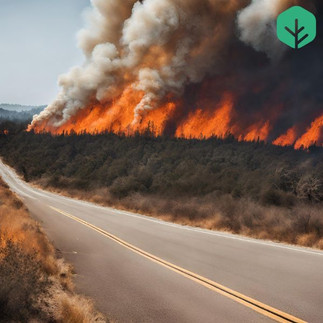In this article:

Introduction
Wildfires are unpredictable and devastating, but did you know that a shocking 85% of them are caused by human activities? Their impact on lives, property, and the environment can be devastating, making wildfire awareness essential.
In this article, we’ll collate some essential wildfire facts since understanding these unpredictable events is crucial for safety, prevention, and ecological awareness.
12 Facts About Wildfires
1. Wildfires are predominantly human caused
Human activities are the leading cause of wildfires. Discarded cigarettes, unattended campfires, malfunctioning equipment, burning debris, and intentional arson all contribute to wildfire ignition. While lightning strikes can cause wildfires, their proportion is significantly smaller.
2. Wildfires need three things to thrive: fuel, oxygen, and heat
Fuel includes dry vegetation like grass, fallen leaves, and trees. Ample oxygen in the air feeds the fire, while sources of heat, like a lightning strike, ember, or cigarette, can cause ignition.
3. Wind is one of the most significant drivers of wildfire spread
Embers carried by the wind can jump long distances, igniting new fires far ahead of the main blaze. Uphill slopes also increase the rate of spread as heat rises faster. This makes strong winds particularly problematic in a wildfire-fighting scenario.
4. Forest fires cause immense destruction
Loss of homes, businesses, and infrastructure are direct consequences. Sadly, wildfires also injure and claim lives. The loss of wildlife and the destruction of fragile ecosystems leaves long-lasting scars. Additionally, smoke from wildfires severely degrades air quality, posing significant health risks.
5. Climate change and wildfires are closely linked
The effects of climate change are undeniable in the increasing frequency and intensity of wildfires. Rising global temperatures create longer, drier fire seasons. Drought turns landscapes into tinderboxes, primed for burning at the slightest spark.
On the other hand, CO2 emissions from wildfires and the destruction of the Earth’s carbon sinks in the form of forests, exacerbate climate change. The relationship between climate change and wildfires is therefore a mutually constitutive vicious circle.
6. Wildfires can create their own weather patterns
Extreme heat can generate fire tornadoes, and the rising smoke column can develop into a pyrocumulonimbus cloud, capable of producing lightning that ignites even more fires. Weather conditions and wildfires can therefore be interrelated.
7. Some wildfires burn underground
In areas with organic-rich peat bogs, wildfires can burn deep underground. These fires smolder slowly, sometimes for months or years, making them extremely difficult to extinguish.
8. Ancient scars
Scientists analyze charcoal deposits in soil and tree rings to track wildfire activity throughout history. This reveals that wildfires have shaped our planet for millennia. However, climate change is fueling modern-day wildfires with greater intensity and destructive force, posing a growing threat worldwide.
9. Animal adaptation
Remarkably, some plants and animals have evolved to survive and even thrive in the aftermath of wildland fires. Certain beetle species sense wildfires from great distances, allowing them to lay eggs in freshly burned wood. Some plants have seeds that require the heat of a fire to germinate.
10. Wildfire smoke
Wildfire smoke can travel thousands of miles and affect air quality far from the fire's location. This smoke can contain harmful substances like carbon monoxide, particulate matter, and volatile organic compounds, posing health risks to populations, particularly those with pre-existing health conditions.
11. Social and mental health effects
Forest fires have profound social and mental health impacts on affected communities. People can experience loss, trauma, and displacement, leading to long-term psychological issues such as anxiety, depression, and PTSD.
12. Economic costs
The economic impact of wildfires extends beyond the immediate destruction of property. It includes costs related to emergency response, rehabilitation of affected areas, lost business, and decreased property values. In the United States alone, the average annual cost of wildfire suppression has exceeded $2 billion in recent years.
Conclusion
Wildfires affect us all, whether directly through the threat to property and lives or indirectly through degraded air quality and damaged ecosystems. However, innovative firetech solutions, from advanced early detection systems to new firefighting technologies, are emerging to help us better understand, prevent, and combat these devastating events.
We cannot afford to be passive bystanders. Inform yourself, stay vigilant, advocate for fire safety practices in your community, and support organizations working to protect our natural resources. Let's make wildfire awareness a year-round priority.















